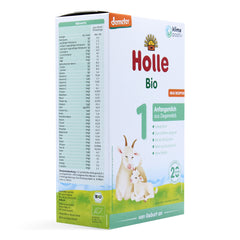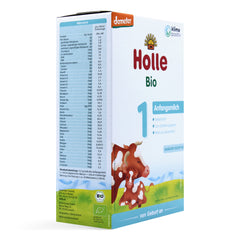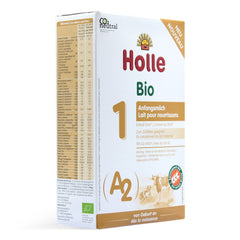Holle vs. Similac: A Comprehensive Ingredient Comparison
46 hours of research 4 minute read

When choosing the best baby formula for your little one, two prominent names often come up: Holle formula and the Similac formula. Both brands are well-regarded and have a loyal following among parents. In this blog, we will delve into the similarities and differences between these two brands, focusing on their ingredients, certifications, and available varieties. This comprehensive guide will help you make an informed decision about which formula is best suited for your baby’s needs.
Similarities Between Holle and Similac
| Feature | Holle Formula | Similac Formula |
|---|---|---|
| Organic Ingredients | Yes | Yes (for some products) |
| GMO-Free | Yes | Yes (for some products) |
| DHA and ARA | Yes | Yes |
| Lactose-Based | Yes | Yes |
| Prebiotics and Probiotics | Yes (in some products) | Yes (in some products) |
| Multiple Stages Available | Yes | No |
| Available in Goat Milk | Yes | No |
| Iron-Fortified | Yes | Yes |
Both the Holle formula and Similac formula share several key features that make them attractive options for parents. They both use high-quality ingredients, avoid GMOs, and provide essential nutrients like DHA and ARA for brain development. Additionally, they offer a range of products tailored to different stages of infant growth.
Origin and Standards of Holle and Similac
Holle Baby Formula originates from Switzerland and Germany, where it has been produced for over 85 years. Holle is renowned for its strict adherence to organic farming standards and biodynamic agricultural practices. Their dedication to excellence guarantees that their formulas have an absence of genetically engineered organisms, harmful pesticides, and chemical fertilizers.
On the other hand, Similac Baby Formula is produced by Abbott Laboratories, a US-based company with a long history of providing infant nutrition products. Similac formulas are developed using cutting-edge science and are designed to meet the nutritional needs of infants and toddlers. While not all Similac products are organic, the brand offers several non-GMO options.
Certifications for Both Holle and Similac
| Certification | Holle Formula | Similac Formula |
|---|---|---|
| Demeter International | Yes | No |
| EU Organic Certification | Yes | No |
| Bioland | Yes | No |
| KRAV | Yes | No |
| USDA Organic Certification | No | Yes (for some products) |
| Non-GMO Project Verified | Yes | Yes (for some products) |
| FDA Approval | Yes | Yes |
Holle Reputation
Strict organic rules in the European Union (EU) have led to Holle's reputation for using superior organic components in their goods. For more than 80 years, parents who appreciate organic and all-natural products have been loyal customers of the brand.
Certifications by Holle
- Demeter International for biodynamic farming methods
- EU Organic Certification
- Bioland
- KRAV
Similac Reputation
Since it has been in existence for more than 90 years, Similac infant formula is a reputable and well-known brand. They are devoted to giving babies nutritious food and are a pioneer in the infant formula sector. Abbott Laboratories is committed to meeting newborns' and kids' nutritional needs, and one of their products is Similac.
They have multiple certifications, such as the Good Housekeeping Seal of Approval and the National Parenting Center Seal of Approval. Given the endorsement of medical professionals including pediatricians and neonatologists, parents often select Similac.
Ingredients Comparison Between Holle and Similac
Holle Ingredients
- Organic lactose
- Organic vegetable oils (palm, rapeseed, sunflower)
- Demeter milk
- Organic maltodextrin
- Organic whey powder
- Prebiotics (GOS)
- DHA and ARA
- Vitamins and minerals
Similac Ingredients
- Nonfat milk
- Lactose
- Vegetable oils (palm olein, soy, coconut, high oleic safflower)
- Whey protein concentrate
- Prebiotics (FOS)
- DHA and ARA
- Vitamins and minerals
- Nucleotides
Holle vs Similac Ingredients (Comparison Chart)
| FORMULA | HYPOALLERGENIC | LACTOSE | CORN SYRUP | MALTODEXTRIN | PALM OIL | SOY OIL | PREBIOTICS | HMOs |
|---|---|---|---|---|---|---|---|---|
| HOLLE BIO | ❌ | ✅ | ❌ | ❌ | ✅ | ❌ | ❌ | ❌ |
| HOLLE A2 | ❌ | ✅ | ❌ | ❌ | ✅ | ❌ | ❌ | ❌ |
| HOLLE GOAT | ❌ | ✅ | ❌ | ❌ | ✅ | ❌ | ❌ | ❌ |
| SIMILAC PURE BLISS | ❌ | ✅ | ❌ | ❌ | ❌ | ✅ | ✅ | ❌ |
| SIMILAC 360 TOTAL CARE | ❌ | ✅ | ❌ | ❌ | ❌ | ✅ | ✅ | ✅ |
| SIMILAC PRO-TOTAL COMFORT | ✅ | ❌ | ❌ | ✅ | ❌ | ✅ | ✅ | ✅ |
| SIMILAC ALIMENTUM | ✅ | ❌ | ❌ | ✅ | ❌ | ✅ | ❌ | ❌ |
| SIMILAC TOTAL COMFORT | ✅ | ❌ | ❌ | ✅ | ❌ | ✅ | ✅ | ❌ |
| SIMILAC ADVANCE | ❌ | ✅ | ❌ | ❌ | ❌ | ✅ | ✅ | ❌ |
| SIMILAC SENSITIVE | ❌ | ❌ | ✅ | ❌ | ❌ | ✅ | ❌ | ❌ |
| SIMILAC NEOSURE | ❌ | ✅ | ✅ | ❌ | ❌ | ✅ | ❌ | ❌ |
Holle Goat Milk Formula and Holle Goat Milk Formula Stage 1 use organic goat milk as their primary ingredient, making them an excellent choice for babies with cow’s milk sensitivities. The use of maltodextrin in Holle formulas provides a gentle source of carbohydrates.
Similac Sensitive Formula and Similac Advance Formula are designed to cater to various dietary needs and sensitivities. Similac uses a combination of nonfat milk and whey protein concentrate, along with vegetable oils, to provide balanced nutrition.
Similarities and Differences
Similarities
- Both brands offer a range of formulas for different stages of infant development.
- They both include essential fatty acids (DHA and ARA) for brain and eye development.
- Lactose serves as the main source of carbohydrates in both.
Differences
- Holle Bio Formula uses biodynamic milk, while Similac Total Comfort Formula uses nonfat milk and whey protein.
- Holle formulas are certified by the EU Organic and Demeter, while Similac offers USDA Organic options.
- Holle Goat Milk Formula is available for infants with cow’s milk sensitivities, whereas Similac does not offer a goat milk variant.
Key Differences Between Holle and Similac
| Feature | Holle Formula | Similac Formula |
|---|---|---|
| Brand Reputation | Organic ingredients for over 80 years | Well-known and reputable for over 90 years |
| Certifications | Demeter International, EU organic, Bioland, KRAV | National Parenting Center, Good Housekeeping Seal of Approval |
| Nutritional Value | Complete, in stages | Complete, from 0-12 months |
| Proteins | Organic Skimmed Milk | Non-Organic Milk. It has a Soy formula and a Hydrolyzed formula. |
| Carbohydrates | Organic lactose and maltodextrin (only some formulas) | Lactose and corn syrup solids. Comfort uses maltodextrin. Most formulas add sugar |
| Fats and Oils | Organic vegetable oils | All formulas contain non-organic soy oil. Similac does not use palm olein like Enfamil. |
| Probiotics and Prebiotics | No probiotics or prebiotics | Most formulas contain GOS or FOS |
| Cost and Availability | Varies per retailer. Exclusively sold online in the US | Widely available in stores and online |
Stages of Holle Formulas
Holle Goat Milk Formula Stages
Holle Goat Milk Formula comes in five stages. Stage PRE and Stage 4 are only available in the regular Holle Goat formula, whereas both Holle Goat formula versions (Dutch and regular goat) have Stages 1-3:
- Holle Goat Stage PRE: Intended for infants aged 0-6 months, and can be given from birth.
- Holle Goat Stage 1: Intended for infants aged 0-6 months.
- Holle Goat Stage 2: Intended for babies aged 6-12 months.
- Holle Goat Stage 3: Intended for toddlers aged 10 months and up.
- Holle Goat Stage 4: Intended for toddlers aged 12 months and up.
- Holle Goat Dutch Stage 1: Intended for infants aged 0-6 months.
- Holle Goat Dutch Stage 2: Intended for babies aged 6-12 months.
- Holle Goat Dutch Stage 3: Intended for toddlers aged 10 months and up.
Holle Cow Milk Formula
The ingredients of Holle cow milk formula are renowned for being clean and simple. The most widely used and accessible formula is cow milk formula, which is produced by Holle in two varieties. Both the Holle A2 formula and the normal Holle cow milk formula are Demeter certified, which means that 99 percent of the ingredients are organic and the remaining 1 percent are non-organic substances such as vital vitamins and minerals that are necessary for a baby's healthy growth and development. The cows are also guaranteed plenty of room to move about and graze freely in biodynamic pastures thanks to the Demeter-certified formula.
Holle Bio Formula
The most popular variety of Holle cow milk infant formula is called Holle Bio Formula, and it is well known for having a simple and clean ingredient list. Holle cow formula contains no GMOs, no soy, no sugar, and no corn syrup. Holle Bio infant formula Stage 1 and Stage PRE do not contain starch, whereas toddler formulas Stage 2-4 do contain organic starch which will fill your baby’s tummy and make them feel fuller for longer. Holle cow formulas contain DHA Omega-3 and Omega-6 sourced from ethically sourced fish oil. Lactose is the primary carbohydrate in Holle Bio formulas.
Holle Bio Formula comes in five stages:
- Holle Bio Cow's Milk Stage PRE: Intended for infants aged 0-6 months, and can be given from birth.
- Holle Bio Cow's Milk Stage 1: Intended for infants aged 0-6 months.
- Holle Bio Cow's Milk Stage 2: Intended for babies aged 6-12 months.
- Holle Bio Cow's Milk Stage 3: Intended for toddlers aged 10 months and up.
- Holle Bio Cow's Milk Stage 4: Intended for toddlers aged 12 months and up.
Holle A2 Formula
Holle A2 formula is made of cow milk from cows that contain the A2 beta-casein protein type. What this means is that Holle A2 formula is easier to digest than regular cow milk baby formula, since A2 milk has shorter fatty acid chains than cow milk without the A2 protein. Because Holle A2 baby formula is simpler to digest, parents of babies with cow milk sensitivity who still want to use cow milk formula occasionally switch from ordinary cow milk baby formula to it. Holle A2 is a lactose-based formula free of sugar, corn syrup, soy, and genetically modified organisms. While Holle A2 Stage 2 and Stage 3 contain organic starch, Holle A2 Stage 1 does not contain any starch. To make a baby feel fuller, small amounts of organic maltodextrin are added to all three stages of the Holle A2 formula.
Holle A2 formula comes in three stages:
- Holle A2 Cow's Milk Stage 1: Intended for infants aged 0-6 months.
- Holle A2 Cow's Milk Stage 2: Intended for babies aged 6-12 months.
- Holle A2 Cow's Milk Stage 3: Intended for toddlers aged 10 months and up.
Top Formulas of Holle and Similac and Where to Buy
Holle Formulas
Looking to buy Holle organic formula? Organic Life Start offers an easy-to-use online platform that enhances affordability and accessibility. This platform ensures a smooth shopping experience with discounts and subscription options. These features help parents save on their favorite Holle formulas and ensure a reliable supply for their baby's nutrition. Organic Life Start prioritizes convenience and value, making it a top choice for parents who want premium organic baby formula delivered straight to their door.
Holle Discount Details:
- Save up to 15% on the largest pack size.
- Get an extra 5% off with recurring subscriptions.
Top Similac Baby Formulas
- Similac Advance Formula
- Similac Sensitive Formula
- Similac Neosure Formula
- Similac Total Comfort Formula
- Similac 360 Total Care Infant Formula
- Similac Toddler Formula
What Sets Holle Apart from Similac?
While this blog focuses on Holle and Similac, it’s worth noting what sets Holle apart from Similac. Holle’s commitment to biodynamic farming, strict organic certifications, and the availability of goat milk formulas distinguish it from other brands. Similac offers USDA Organic-certified products and advanced nutritional formulations, but Holle's Demeter certification and European origins provide a different level of quality assurance and farming practices.
Both Holle formula and Similac formula provide excellent options for infant nutrition, each with its unique strengths. Understanding the ingredients, certifications, and available varieties can help you choose the best formula for your baby’s specific needs.
Most Popular Holle Baby Formulas
Organic Life Start is committed to providing accurate, reliable, and trustworthy information to parents and caregivers. We carefully choose credible sources and follow a meticulous fact-checking process to uphold the highest standards in infant nutrition and parenting advice. To learn more about our dedication to accuracy, please explore our editorial guidelines.
Link To Sources











Paloma -
Looking back, I really wish I had known about the difference in ingredients between Holle and Similac when my baby was dealing with constant reflux and discomfort. We started out with Similac since it was what the hospital provided, and I didn’t think twice—it felt like the “normal” choice. But within weeks, my baby was miserable: spitting up after every feed, super gassy, and barely sleeping. I blamed myself at first, thinking it was just part of newborn life. It wasn’t until I dug into the ingredient list that I realized how many unnecessary additives were in his formula.
That’s when I came across Holle, and honestly, I was shocked at how clean and straightforward the ingredients were—real organic milk, no palm oil, and no synthetic fillers. After switching, it felt like I had a completely different baby. Happier, calmer, and finally sleeping longer stretches. I just wish I had found this kind of comparison sooner—it would’ve saved so much stress.
Aliya -
I’ve always used Similac because it’s what my doctor recommended from the start, but now I’m curious about trying Holle. I never really paid attention to ingredient labels until recently, and wow—there’s a huge difference between the two. The simplicity and organic sourcing in Holle’s formula honestly make Similac look overly processed in comparison. I’m not judging anyone’s choice (we all do what works!), but learning about things like added sugars and synthetic nutrients really made me pause. Has anyone switched from Similac to Holle? Did your baby notice a difference in taste or digestion? I’m a little nervous to try something new, but if it means cleaner ingredients and better nutrition, it might be worth it.
Aden Crider -
What makes European Holle formula stand out from Similac is its commitment to organic farming and clean ingredients. Holle uses milk from biodynamic farms, which follow strict EU organic regulations and emphasize animal welfare, sustainability, and soil health. Unlike Similac, Holle avoids corn syrup, artificial preservatives, and synthetic nutrients, opting instead for natural sources of vitamins and minerals. One of the biggest differences I noticed was how easily my baby digested Holle—less gas, fewer spit-ups, and more regular bowel movements. Similac, while widely trusted and available, contains ingredients like palm oil and added sugars that didn’t sit well with my child. I also appreciated that Holle formulas are simpler, with fewer but higher-quality ingredients. At first, I was hesitant due to the price and availability, but the improvement in my baby’s comfort and mood made it worth it. I realized that investing in better nutrition from the start is not just about feeding—it’s about overall well-being. The peace of mind I felt knowing my baby was consuming clean, responsibly sourced formula made a big difference. Switching to Holle was one of the best parenting decisions I’ve made.